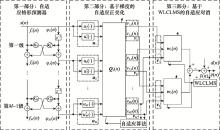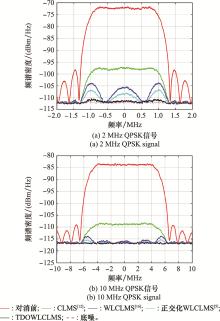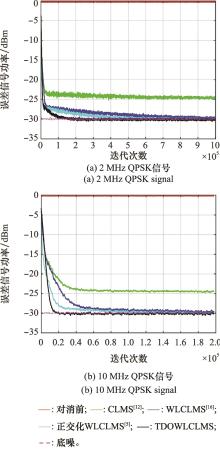Systems Engineering and Electronics ›› 2022, Vol. 44 ›› Issue (9): 2726-2735.doi: 10.12305/j.issn.1001-506X.2022.09.04
• Electronic Technology • Previous Articles Next Articles
Two-dimensional orthogonalization WLCLMS scheme for self-interference cancellation
Zhongpu CUI1,2, Songhu GE1,2,*, Yaxing LI1,2, Yu GUO1,2, Mingliang XIE1,2, Jin MENG1,2
- 1. Institute of Military Electrical Science and Technology, Naval University of Engineering, Wuhan 430033, China
2. National Key Laboratory of Science and Technology on Vessel Integrated Power System, Naval University of Engineering, Wuhan 430033, China
-
Received:2021-12-23Online:2022-09-01Published:2022-09-01 -
Contact:Songhu GE
CLC Number:
Cite this article
Zhongpu CUI, Songhu GE, Yaxing LI, Yu GUO, Mingliang XIE, Jin MENG. Two-dimensional orthogonalization WLCLMS scheme for self-interference cancellation[J]. Systems Engineering and Electronics, 2022, 44(9): 2726-2735.
share this article
| 1 | SABHARWAL A , SCHNITER P . In-band full-duplex wireless: challenges and opportu-nities[J]. IEEE Journal on Selected Areas in Communications, 2014, 32 (5): 1637- 1652. |
| 2 | DUARTE M, SABHARWAL A. Full-duplex wireless communications using off-the-shelf radios: feasibility and first results[C]//Proc. of the 44th Asilomar Conference on Signals, and Computers, 2010: 1558-1562. |
| 3 |
DUARTE M , DICK C , SABHARWAL A . Experiment-driven characterization of full-duplex wireless systems[J]. IEEE Trans. on Wireless Communications, 2012, 11 (12): 4296- 4307.
doi: 10.1109/TWC.2012.102612.111278 |
| 4 | BHARADIA D , MCMILIN E , KATTI S . Full duplex radios[J]. ACM Special Interest Group Data Communication Computation Communication, 2013, 43 (4): 375- 386. |
| 5 |
LI Z , XIA Y L , PEI W J . An augmented nonlinear LMS for digital self-interference cancellation in full-duplex direct-conversion transceivers[J]. IEEE Trans.on Signal Processing, 2018, 66 (15): 4065- 4078.
doi: 10.1109/TSP.2018.2846250 |
| 6 |
GE S H , XING J L , LIU Y C , et al. Dual-stage co-site RF interference canceller for wideband direct-conversion receivers using reduced observation chain[J]. IEEE Trans.on Electromagnetic Compatibility, 2020, 62 (3): 923- 932.
doi: 10.1109/TEMC.2019.2914369 |
| 7 |
GE S H , MENG J , XING J L , et al. A digital-domain controlled nonlinear RF interference cancellation scheme for co-site wideband radios[J]. IEEE Trans.on Electromagn-etic Compatibility, 2019, 61 (5): 1647- 1653.
doi: 10.1109/TEMC.2018.2871129 |
| 8 |
EVERETT E , SAHAI A , SABHARWAL A . Passive self-interference suppression for full-duplex infrastructure nodes[J]. IEEE Trans.on Wireless Communications, 2014, 13 (2): 680- 694.
doi: 10.1109/TWC.2013.010214.130226 |
| 9 | KRIER J, RAND I, AKYILDIZ F. Active self-interference cancellation of passband signal using gradient descent[C]//Proc. of the IEEE 24th Annual International Sympos-ium on Personal, Indoor, and Mobile Radio Communications, 2013: 1212-1216. |
| 10 |
VOGT H , ENZNER G , SEZGIN A . State-space adaptive nonlinear self-interference can-cellation for full-duplex communication[J]. IEEE Trans.on Signal Processing, 2019, 67 (11): 2810- 2825.
doi: 10.1109/TSP.2019.2910490 |
| 11 |
HONG S , BRAND J , CHOI J I , et al. Applications of self-interference cancellation in 5G and beyond[J]. IEEE Com-munications Magazine, 2014, 52 (2): 114- 121.
doi: 10.1109/MCOM.2014.6736751 |
| 12 |
AHMED E , ELTAWIL M A . All-digital self-interference cancellation technique for full-duplex systems[J]. IEEE Trans.on Wire-less Communications, 2015, 14 (7): 3519- 3532.
doi: 10.1109/TWC.2015.2407876 |
| 13 | LI X, TEPEDELENLIOGLU C. Maximum likelihood channel estimation for residual self-interference cancellation in full duplex relays[C]//Proc. of the 49th Asilomar Conference on Signal, System and Computer, 2015: 807-811. |
| 14 | ZHANG L W, JIANG H J, LI F L, et al. A LUT-free DC offset calibration method for removing the FPGA gain-correlated offset residue[C]//Proc. of the IEEE International Symposium on Circuits and Systems, 2013: 1704-1707. |
| 15 |
VALKAMA M , GHADAM A S H , ANTTILA L , et al. Advanced digital signal processing techniques for compensation of nonlinear distortion in wideband multicar-rier radio receivers[J]. IEEE Trans.on Microwave Theory and Techniques, 2006, 54 (6): 2356- 2366.
doi: 10.1109/TMTT.2006.875274 |
| 16 |
KORPI D , ANTTILA L , SYRJALA V , et al. Widely linear digital self-interference cancellation in direct conversion full-duplex transceiver[J]. IEEE Journal on Selected Areas in Communications, 2014, 32 (9): 1674- 1687.
doi: 10.1109/JSAC.2014.2330093 |
| 17 | ANTTILA L. Digital front-end signal processing with widely-linear signal models in radio devices[D]. Province of Western Finland: Tampere University of Technology, 2011. |
| 18 |
KWONG R , JOHNSTON E . A variable step-size LMS algorithm[J]. IEEE Trans.on Signal Processing, 1992, 40 (7): 1633- 1642.
doi: 10.1109/78.143435 |
| 19 | HAYKIN S . Adaptive filter theory[M]. 4th ed Upper Soddle River, NJ: Prentice-Hall, 2002. |
| 20 | ATTALLAH S, NAJIM M. On the convergence enhance-ment of the wavelet transform based LMS[C]//Proc. of the Acoustics, Speech and Signal Processing, 1995: 973-976. |
| 21 |
NARAYON S , PETERSON A , NARASIMHA M . Transform domain LMS algorithm[J]. IEEE Trans.on Acoustics, Speech and Signal Processing, 1983, 31 (3): 609- 615.
doi: 10.1109/TASSP.1983.1164121 |
| 22 |
WIDROW B , WALACH E . On the statis-tical efficiency of the LMS algorithm with nonstationary inputs[J]. IEEE Trans.on Information Theory, 1984, 30 (2): 211- 221.
doi: 10.1109/TIT.1984.1056892 |
| 23 | LI Z, PEI W J, XIA Y L, et al. Widely linear CLMS based cancellation of nonlinear self-interfere-ence in full-duplex direct-conversion transcei-vers[C]//Proc. of the IEEE International Conference on Acoustics, Speech and Signal Processing, 2018: 4329-4333. |
| 24 | GE S, CUI Z P, XING J L. Adaptive nonlinear digital interfe-rence cancellation with two dimensional orthogonalization for co-site radios[C]//Proc. of the IEEE MTT-S International Wireless Symposium, 2021. |
| 25 | DOUGLAS S. Performance analysis of the conventional complex LMS and augmented complex LMS algorithms[C]//Proc. of the IEEE International Conference on Acoustics, Speech and Signal Processing, 2010: 3794-3797. |
| 26 | ERIKSSON J , KOIVUNEN V . Complex random vectors and ICA models: identifiability, uniqueness, and separability[J]. IEEE Trans.on Information Theory, 2006, 52 (4): 1017- 1029. |
| 27 | KAILATH T . Linear systems[M]. Englewood Cliffs, NJ: Prentice-Hall, 1980. |
| 28 | 欧世峰, 高颖, 赵晓晖. 基于随机梯度的变动量因子自适应白化算法[J]. 自动化学报, 2012, 38 (8): 1370- 1374. |
| OU S F , GAO Y , ZHAO X H . Stochastic gradient based variable momentum factor algorithm for adaptive whitening[J]. Acta Automatica Sinica, 2012, 38 (8): 1370- 1374. | |
| 29 | 管鹏鑫, 汪奕汝, 赵玉萍. 基于正则化的全双工通信系统非线性自干扰消除方法[J]. 北京大学学报(自然科学版), 2021, 57 (6): 991- 996. |
| GUAN P X , WANG Y R , ZHAO Y P . A regu-larization based nonlinear self-interference suppression method for full duplex communic-ation systems[J]. Acta Scientiarum Naturalium Universitatis Pekinensis, 2021, 57 (6): 991- 996. | |
| 30 |
LIU Y , QUAN X , PAN W S . Digital assisted analog interfe-rence cancellation for in-band full-duplex radios[J]. IEEE Communication Letters, 2017, 21 (5): 1079- 1082.
doi: 10.1109/LCOMM.2017.2652444 |
| [1] | Yangliang WAN, Xingdong LIANG, Yanlei LI. Interference suppression method based on azimuth frequency domain filtering for airport millimeter-wave radar [J]. Systems Engineering and Electronics, 2022, 44(11): 3357-3363. |
| [2] | Zengmao CHEN, Li LU, Zhiguo SUN, Rongchen SUN. Parameter estimation algorithm of convolutional codes with solving cost function based on conjugate gradient [J]. Systems Engineering and Electronics, 2022, 44(10): 3235-3242. |
| [3] | Tianyi JIA, Jingjie GAO, Xiaohong SHEN, Hongwei LIU. Moving underwater vehicle localization with uncertain sound speed [J]. Systems Engineering and Electronics, 2022, 44(9): 2699-2706. |
| [4] | Yili HU, Yongbo ZHAO, Sheng CHEN, Ben NIU. Decoherence of conformal electromagnetic vector sensor array by double interpolation fitting method [J]. Systems Engineering and Electronics, 2022, 44(8): 2393-2402. |
| [5] | Ying KANG, Zhihua ZHAO, Hao WU, Yaxing LI, Jin MENG. Deep SVDD-based anomaly detection method for communication signals [J]. Systems Engineering and Electronics, 2022, 44(7): 2319-2328. |
| [6] | Juan WEI, Shian YAN, Fangli NING. DOA estimation method for coherent signals based on coprime array virtual array spatial smoothing [J]. Systems Engineering and Electronics, 2022, 44(4): 1069-1077. |
| [7] | Shiyan SUN, Gang ZHANG, Weige LIANG, Bo SHE, Fuqing TIAN. Remaining useful life prediction method of rolling bearing based on time series data augmentation and BLSTM [J]. Systems Engineering and Electronics, 2022, 44(3): 1060-1068. |
| [8] | Yan JIN, Dadi ZHAO, Hongbing JI. Parameter estimation of LFM signals based on NAT functions in impulsive noise [J]. Systems Engineering and Electronics, 2022, 44(3): 762-770. |
| [9] | Baohua FAN, Le ZUO, Yong TANG, Zehua HU. DOA estimation of multiple time-varying signals with expectation-maximization algorithm [J]. Systems Engineering and Electronics, 2022, 44(2): 420-426. |
| [10] | Jianxing LIU, Tianqi ZHANG, Haojun BAI, Shaopeng YE. Blind recognition algorithm of polar code based on information matrix estimation [J]. Systems Engineering and Electronics, 2022, 44(2): 668-676. |
| [11] | Xuan XIE, Hui FENG, Bo HU, Dan LI. Design of optimal sampling set for bandlimited graph signal [J]. Systems Engineering and Electronics, 2022, 44(2): 357-364. |
| [12] | Lingzhi QU, Junan YANG, Hui LIU, Keju HUANG. Method for individual identification of communication radiation source embedded in attention mechanism [J]. Systems Engineering and Electronics, 2022, 44(1): 20-27. |
| [13] | Wenjun YAN, Yuyuan ZHANG, Qing LING, Keyuan YU, Kaiwen TAN, Hengyan LIU. Blind recognition algorithm of space frequency block codes based on frequency domain cross correlation sequence and peak detection [J]. Systems Engineering and Electronics, 2021, 43(12): 3709-3715. |
| [14] | Yongjie CHENG, Shuai LIU, Xue ZHANG, Ming JIN. Robust beamforming algorithm based on Gauss-Legendre integral [J]. Systems Engineering and Electronics, 2021, 43(11): 3144-3150. |
| [15] | Yuyuan ZHNAG, Wenjun YAN, Limin ZHANG, Yuan ZHANG. Blind recognition algorithm of serial space-time block code based on convolutional neural network [J]. Systems Engineering and Electronics, 2021, 43(11): 3360-3370. |
| Viewed | ||||||
|
Full text |
|
|||||
|
Abstract |
|
|||||













